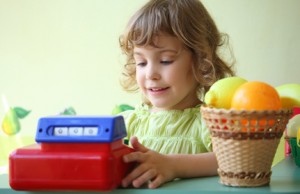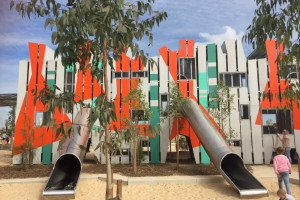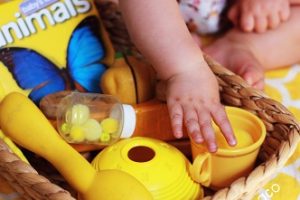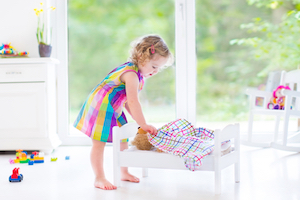As parents we all want to give our child the best start in life. We want to give them as many opportunities as possible to reach their full potential. We aim to create the best learning environment at home to enable them to develop their skills in many areas. This is particularly true when it comes to education.
My name is Kelly Pisani and I am an experienced educator and mother of two children. This article focuses on games that you can play with your preschooler to give them a head start in understanding numeracy (mathematics) and literacy (English) concepts prior to Kindergarten.
Children learn best through play experiences. We can maximise their learning by setting up games that have a purpose of teaching them about Mathematics and English while still being very engaging and above all, fun! Children learn new concepts at the point of need. This means that children are only ready to learn a new skill if it is important for them at that exact time. (e.g. learn to write their name on their painting so they don’t mix it up with others)
Below is a list of 3 imaginative games that target these learning outcomes and a list of parent tips to get the best out of each game.
1. Doctors and Nurses
All children experience going to the doctors and visiting the nurse at some stage before they go to school. Unfortunately for some, a little more often then others. This is a familar context (situation) for your child, so your child will be really engaged with this game.
How to set it up
Get your child to talk to you about what you would need to set up for this game. You would ne

Parent tips on playing the game
1. Be as creative as you can with your costumes. Get your child to help you write some name tags that could be used when you or your child is playing a character. Talk about the names and sounds of all the letters on each name tag. (literacy) Name tags could include Doctors, nurses, receptionists and patients
2. Get your child to play different roles. You also play a role so they can see what you say and what you do when you play a character. Children learn so much through observation. Play the receptionist role first, and demonstrate how you write down the patients name, what time their appointment is and then you put it into a tray for the doctor. You could focus on showing your child the clock and show them where the hands of the clock have to be to show that time. (Mathematics) Encourage your child to keep watching the clock until it is their appointment time.
3. You and your child can make up forms that patients need to fill in when they arrive. It could have a space for the name, age, doctor they are seeing and time of the appointment. (Literacy) Have your child write the words with your guidance.
4. In the doctors room you could get the doctor to check the temperature, blood pressure, look at sore body parts, conduct an X-ray, give advice on what to do to get better, give a needle and write out a prescription for medicine. You can help the child write out a prescription and draw a picture to represent it. (literacy)
5. Get the patient to pay at the reception when they have finished their appointment. (Have play money and use each coin as one dollar). The child has to count the amount of coins that they have to give the receptionist. (Mathematics)
You can play this game over and over again with a different scenario. Get your child to play different roles constantly and give them lots of praise for communicating in character.
2. Post Office
A post office environment may be less familar to young children but it offers so many opportunities for children to learn literacy and numeracy concepts. You could take your child to a post office before you play it so they have some understanding of what happens in a post office and what its purpose is to the community.
How to set it up
Get your child to talk to you about what you would need to set up for this game. You would need to include a table for where the post office assistant will sit, an area for customers to write letters, put stamps on and get their parcels ready to be sent, an area for customers to line up and a post box to put all letters and parcels in.
Parent tips on playing the game
1. Get your child to help you to collect and sort all the equipment that you need for the game. You will need to gather blank pieces of paper, small envelopes, large envelopes, pencils, stamps, bubble wrap and sticky tape. (You can make envelopes and stamps out of paper or cardboard) Get your child to write labels for each of the stationary to put up in the post office so the customers know where to find them on the shelves. (literacy) Do not forget to include how much they are. (mathematics)
2. Get the customer to buy some stationary that they need to send a letter to someone they know. They will need to purchase the paper, pencil, stamp and envelope from the front counter. Ask lots of questions to your child about what they have. (e.g. how many things are you buying?, if you bought another pencil what would your new number be? – Mathematics)
3. Help your child construct a letter to someone they know. Focus on the structure of a letter. (who is it to?, what do you want to say? who is it from?) Get your child to help you identify the sounds and names of the letters being used. (literacy)
4. Show your child what we put on an envelope (the name and address of the recipient on the front, the sender details on the back, the stamp on the top right hand corner of the front of the envelope) – Literacy
5. Get your child to write an invitation for a party to send. Focus on the structure of the invitation (who, what, where, when, rsvp) Ask your child how many invitations would you need to send to your whole family? – Mathematics
6. Make a parcel to send to someone. Wrap it in bubble wrap and explain why we have to protect it. Explain the whole process of how their parcel gets from the post office to the person they are sending it to. Your child may want to role play that process.
7. Talk about the price of stamps. (you can make up a simple amount e.g. $1) Ask them if they needed 3 stamps how much it would cost? (Mathematics)
After playing this game many times you might want to take your child to the post office to send a real letter to a friend or family member. You can get them to buy the stamp, put it on the letter and then put the letter in the post box. This will translate their knowledge into the real world.
3. Toy shop

How to set it up
Dedicate an area in your house to be used as a toy shop for a couple of days. It is important not to pack it up as soon as you have finished as this game could be played each day so your child can build on the skills he/ she has learnt on the previous day. Use lots of print in the toy shop to help your child with the beginning stages of reading.
Parent tips on playing the game
1. Let your child choose a name for the shop and together make a poster with the shops name on it. Focus your child’s attention on the letter names and sounds in the name of the shop. (Literacy)
2. Encourage your child to set up the toys in lines and count how many he/she has of each type of toy (13 – cars, 16 – soft animal toys) Get your child to record how many they have with a numeral and picture on a sheet. When someone buys a toy they can cross off one of them so they always know how many they have on their shelves. (Mathematics)
3. Make advertisements with your child to encourage family members to buy toys from their shop. Stick them up around the house. (Literacy)
4. Assign dollar amounts to each toy and make a sign to stick near the toy. Talk about how we write money amounts. Talk about the dollar sign with your child. (Mathematics)
5. Count dollar coins to pay for toys being bought (Mathematics)
6. The child can give customers a receipt documenting what they have purchased. Parents can help with spelling or they could use the signs in the shop to help spell toy names. (Literacy)
The best gift you can give your child is a variety of experiences. Although many of us are time poor, it is essential that we make as much time as possible to play and communicate with our young children. Playing is how children learn. As parents if we invest a little time in preparing purposeful play, children will reap the rewards of having a deeper knowledge and understanding of many numeracy and literacy concepts.















